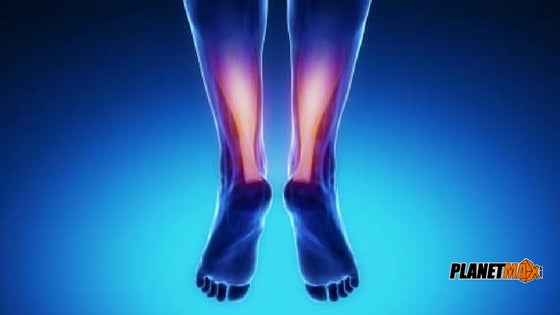When performed correctly the Squat is one of the most beneficial exercises for muscular growth, strength, toning and all round conditioning. Unfortunately it is not always executed in a productive or safe manner. The main cause of poor squatting form, particularly with males, is trying to use too much weight. However lately I have noticed several well-intentioned individuals struggling with their form even though they had dropped their egos and selected sensible weights (females, so hard for the boys when it comes to strength). So this month we are going to look at another common cause of poor squatting form – inflexibility through the Achilles Tendon.
The Achilles tendon connects the heel to the two calf muscles (gastrocnemius and soleus) and is the thickest/strongest tendon in the body. Contracting the calf muscles pulls the Achilles tendon, which pushes the foot downward (plantar flexion for the boffins). This contraction enables standing on the toes, walking, running, and jumping.
If the Achilles tendon is too tight two things can happen while squatting and to some extent while deadlifting as well.
1: As the knee bends on the negative phase the inflexible Achilles tendon will cause the heels to lift up of the ground. This will make the exercise less stable and limit the amount of weight that can be correctly used.
2: Or to keep the heels flat on the ground the person will try to bend less at the knees and instead lean forward more at the hips. Again this is not desirable as extra stress will be placed on the lower back muscles and spine.
A simple two-step process will correct this problem and allow you to get the most benefit out of Squats and Dead lifts. Be patient, it generally takes most people a few months to achieve the desired results.
Step 1. Sounds too simple but regular stretching of the Achilles tendon will over time give you greater movement. The best time to stretch any muscle is when it is warm, which is AFTER your exercise session. A prominent Australian Physiotherapist, Rodney Pope, conducted extensive testing of Australian Army recruits over a 2 year period and found no reduction in injury for those that stretched before exercise. There was a significant reduction in injuries for those who stretched after exercise however.
The Achilles tendon is stretched every time you point your toes up thus stretching the calf. Place one foot 30 cm in front of the other, resting on your heal with the front leg straight. Now point the toes up and instantly feel the stretch. Hold this position for 10-15 seconds. For a greater stretch slowly lean forward.
Step 2. This step is going to be the lesser of two evils for a few weeks/months but it will take us to where we want to go. Instead of fighting the urge to come up on to the toes as we squat we will temporarily work with it and place a
board or plates under the heel. The starting thickness is generally 2-3cm with the goal of reducing the thickness of the board every few weeks as flexibility increases until we no longer require the board/plates at all. Stability with the board will be improved and a more upright posture will be possible while squatting. The downside is that this will cause the knees to track over the toes slightly more than the ideal position. By dropping the weight and performing controlled/slow reps any extra stress on the knees will be minimal if at all.
There you have it, a 2 step simple plan to increase the flexibility of the Achilles tendon. While this will help with your squatting and deadlifting, a flexible Achilles tendon will benefit all other sporting activities, particularly jogging. If you are experiencing sharp pain through the tendon or calf while exercising it is probably something more than just inflexibility, best to consult a doctor or physiotherapist.
